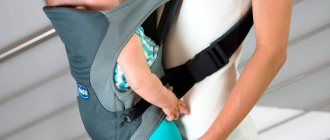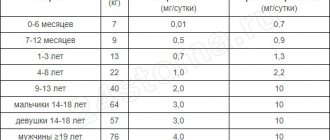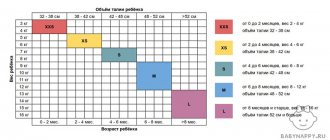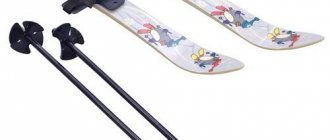Many parents are interested in the question: can children wear contact lenses? The safety of these optical products for children's eyes raises many doubts among adults. It is a common belief that children are allowed to use contact lenses only after reaching adulthood. What do ophthalmologists think about this and what is the situation really like?
Can children wear contact lenses?
The use of glasses in children is more reasonable; there is no need to monitor hygiene and regularly wash the products. But since many children are embarrassed to tell others about their poor vision, parents are interested in the question of whether they can wear lenses.
You can wear contact vision correction devices, but from a certain age. Optics are prescribed for astigmatism, myopia, hypermetropia, congenital cataracts, keratoconus and congenital deviations from the normal size of the lens.
At what age should you start learning how to put it on yourself?
Many parents do not trust contact lenses and prefer regular glasses. Such fears are unfounded, since the safety of contact lenses for children has been confirmed by research.
Ophthalmologists recommend installing contact lenses from primary school age . But if the appearance of myopia is noticed earlier, then there are no contraindications due to age. The main thing is that the child understands the risks associated with neglecting hygiene.
Recommendations for training
To avoid complications or vision deterioration, you must follow some rules.
- Cleaning and storage solutions must be purchased from the same brand as the lenses themselves.
Otherwise, deformation or clouding may occur. The solution should be changed after each use of such products. It is strictly forbidden to use tap or other water to store contact optics. - Children should know that contact lenses are for individual use only. Even one-day products do not need to be given to friends with impaired vision, as they are selected individually by the doctor.
- Before swimming in open waters and pools, the optics must be removed, otherwise pathogenic microbes can get under the lens and cause inflammation.
- When using other drops, you should consult your doctor, as they may damage the surface of ophthalmic products.
Contact lenses are a safe method of vision correction . Of course, you need to remember various nuances and carefully monitor the condition of your eyes. Only in this case they will not cause inconvenience and will not cause harm to health.
Minimum age to wear contact lenses
The question of at what age children can wear contact lenses is relevant among parents. It is advisable to switch to their use during adolescence.
Soft daytime
Soft contact lenses are safe for children and teenagers. Doctors prescribe them from the age of eight, because at this time they can already put on and take off independently, monitor hand hygiene and properly care for optical products.
Studies have shown that complications develop even less frequently than in adults. Because they are more responsible about the cleanliness and care of optical products.
SCLs are worn only during the daytime. They are gas permeable and have a high water content. Does not dry eyes or cause dry eye syndrome.
Nights are hard
Orthokeratology products are intended for use at night. They should be worn at least 8 hours a day. During this time, they affect the cornea and improve the clarity of vision.
In the morning, the night vision correction devices are removed and the entire day goes without them. No need to wear glasses. By evening, vision deteriorates, so you need to use them every night.
Such contact lenses can be used by children from 10 years of age. Mainly prescribed for deformation of the lens or cornea, keratoconus. Also, orthokeratological means of contact vision correction stop the development of myopia. After 1 year of use, vision improves significantly.
Colored
These optical products can be used for holidays, carnivals and everyday wear.
It is not advisable for children to use colored contact lenses for vision correction and treatment of eye pathologies.
Contact lenses are harmless for children. Myth or reality?
Contact lenses for children are really harmless, that's true. Modern manufacturing companies produce products that have a safe composition, and the medical community carefully monitors this.
In some cases, it would be true to say that children even need to wear lenses - this type of vision correction has many advantages, among which the following are worth highlighting:
• the opportunity to lead an active lifestyle, attend physical education classes, clubs and sports sections without discomfort. • guarantee of a full viewing angle, which is impossible when wearing glasses. • saving. Today, high-quality frames with good lenses are not cheap, and the loss of glasses threatens parents with another considerable expense. It is much easier and cheaper to purchase a new package of lenses. • maintaining the usual appearance. All children are extremely vulnerable, which means few people want to be teased as “bespectacled”, so contact lenses for children are the optimal solution to the problem of poor vision.
Eye safety
Contact optics are absolutely safe with proper care. Children are more active, run a lot and play sports. Glasses can break at the most inopportune moment, but contact lenses will not fall out of the eye.
If you put it on with dirty hands, you may get an infection and develop an inflammatory process. To prevent this from happening, parents will initially have to control the process of putting on and taking off the optics.
Otherwise, contact vision correction products are absolutely safe, and even safer than glasses.
Contact lenses are better, and there is plenty of evidence:
- CLs stick to the cornea. They move with your baby's eyes, providing full vision. Peripheral vision improves.
- Contact products do not fog up in cold weather. When it rains, they don’t interfere with your ability to see the world around you normally.
- They have no frame and are difficult to notice to others.
- Do not fall when tilting your head forward while reading or putting on shoes.
The main advantage is the child’s psychological comfort. Adolescents' self-esteem increases when using CL. Using glasses, unpleasant words can be directed at them, causing self-doubt, which subsequently affect their academic performance and position in society.
Lenses for an active lifestyle
A child with glasses is not always a quiet, assiduous baby. Children with poor eyesight can also be active: play outdoor games, run in school corridors and on the street, and engage in physical education along with other children.
Glasses are uncomfortable - they slide off your nose and can fall and break. Glasses can also cause eye injury.
Why you should try wearing contact lenses:
- During physical education and sports, wearing glasses is uncomfortable, and without glasses it is even worse. In many sports, glasses are prohibited by safety regulations. If your child's coach does not allow glasses to be worn during soccer or basketball, he or she is following safety guidelines. Read our article about lenses and sports.
- To see clearly without interference. Contact lenses provide a natural angle of peripheral vision - nothing interferes with your vision.
- The eyeball grows slowly. The specialist will measure it at your scheduled appointment and, if necessary, write a new prescription for lenses. You just buy new lenses - you don’t need to order anything or wait a long time.
- The child feels more confident in the lenses because he is no longer “bespectacled.”
Lenses are made from hydrogel or silicone hydrogel. They allow oxygen to reach the cornea, are almost never felt like a foreign body in front of the eyes, and help maintain eye moisture levels at a natural level.
How to choose lenses for a child
The selection of funds is carried out by an ophthalmologist. At the first visit to the doctor, he prescribes a full examination intended for young and young patients.
The ophthalmologist examines the condition of the front part of the eye to exclude contraindications that would make the use of CL impossible. Then the doctor uses special instruments to determine the parameters of the child’s eye.
It is important to find out the base curve, diameter, degree of visual impairment and optical power. The doctor provides a product that meets the listed parameters. The child walks in it for 2–3 hours and talks about the sensations.
An ophthalmologist examines the fundus of the eye in the product and determines the clarity of visual perception. If they are suitable in all respects and do not cause visual distortion, discomfort, irritation or redness, the doctor writes a prescription.
If necessary, the patient tries on several types of optics to choose the most optimal option.
It is recommended to use one-day products. Such products are put on in the morning and disposed of in the evening. They are the safest, eliminating the risk of infection, since they are not reused. One-day products do not require any maintenance.
Let your child decide for himself what to wear: glasses or contacts
Many parents do not offer their child ways to solve vision problems, but impose them on them. They categorically do not want to listen to the child’s requests to buy lenses. Arguing this in the following words:
- Why do you need lenses? It is expensive. Let's better buy glasses. They will correct your vision well. And we won't have to buy new ones for several years.
- You are still too young to use contact lenses instead of glasses.
- You will not be able to follow the rules for caring for your lenses. Let's better buy you regular glasses. They are easier to use.
Each of these answers is incorrect. By reacting to a teenager's requests in this way, you ruin his mood. You don’t give me the opportunity to make a choice without your help. This means you don’t allow the teenager to be independent.
Instead of taking away your child's right to choose, give him the opportunity to decide for himself what accessory to wear. Most teenagers have their own opinions on this matter. And they want their parents to listen to him.
If you absolutely do not want to buy lenses for your child, buy nice glasses
If no amount of persuasion from your child works on you, and you still don’t want to buy him lenses, then offer an alternative. Buy beautiful, expensive glasses. Which will look stylish, fashionable, youthful. And, at the same time, they will effectively correct vision.
It's the twenty-first century. The business sector that produces glasses is quite well developed. If you need to correct your vision, this does not mean that you need to buy only ugly accessories. Which will cause ridicule from the child’s classmates.
You can order custom glasses for your teenager. Choose their shape. Frame. Color. And many other aspects. Thanks to this you will create truly beautiful glasses. Which the child will be comfortable to wear. And which will become a worthy alternative to lenses.
Long-term wear lenses for children
Reusable optical products are permitted. The recommended period is no more than 30 days. Longer-lasting contact lenses are allowed to be purchased during adolescence.
The shorter the period of use of optics, the better. Children do not always follow proper hygiene rules and may sometimes forget to replace the disinfectant solution in the container.
Caring for long-term wearing products is not difficult. It is necessary to rinse the products for 5 seconds on each side with a multifunctional solution. The neck of the bottle with liquid must not come into contact with any surfaces.
The liquid in the container is also changed daily, since the previous one may contain a large number of pathogenic microorganisms. Before changing the solution in the container, it is washed with distilled water and dried. The container itself is changed monthly.
If the solution runs out, you cannot pour it into another bottle. It is not recommended to mix solutions from different manufacturers.
Proper storage and care of lenses will keep your eyes healthy. Regular replacement is not done for fun, it is extremely important to protect the eyes from infections.
How to use lenses?
Before starting use, it is important to study the instructions; often at places of purchase they can advise on how to put them on correctly, because for those who buy lenses for the first time, this can become a real problem, and for people who have been wearing them for a long time, this procedure should not cause any problems. difficulties. For beginners - don’t be alarmed if you can’t do it right away, after a little training you’ll learn
And the most important thing is that you will be able to appreciate all the delights of using lenses. At first it may be very unusual, because your vision will be like your own, without the use of glasses, but everyone will certainly get used to this condition. But they do it smoothly
For beginners - don’t be alarmed if you can’t do it right away, after a little training you’ll learn
And the most important thing is that you will be able to appreciate all the delights of using lenses. At first it may be very unusual, because your vision will be like your own, without the use of glasses, but everyone will certainly get used to this condition. But they do it smoothly
On the first day it is recommended to stay in them for an hour, but on each subsequent day you should increase the time you spend in them. In this way, a person avoids a lot of stress on the eyes and psychologically gets used to the foreign body.
It is very important to monitor the expiration date of the lenses and the solution in which they are stored; it must be renewed in storage containers every day. If you haven’t worn them for three days, then you can leave the solution
Nowadays you can choose lenses with different wearing periods, whatever is most convenient for you; there are lenses that you can wear continuously for a month, or even three, or those that you need to take off every day. It is important at any time - do not forget to update them, in order to avoid deterioration of vision and eye damage.
In most cases, contact lenses are used to eliminate problems with vision, to correct it; this product has become quite widely used in our time due to its safety, convenience, effectiveness and inconspicuousness. A person with poor vision is no longer required to wear glasses. But in addition to vision-correcting lenses, there are also decorative products - colored lenses, which are worn to change the color of the eyes, or to give them greater brightness and saturation.
The number of people in the world suffering from vision problems is increasing every year, but technology is also developing along with the growth of this problem. Monitor your vision and use the most convenient and comfortable means for you to improve it.
How to put on and remove lenses
Children from 8 years of age can put on contact lenses independently. They face some difficulties in use at first, so parents should know how to put on and take off contact products.
Putting on sequence:
- Wash your hands with antibacterial soap, wipe with wet wipes or use a disinfectant spray. Wipe with a dry towel, because the product will stick to wet fingers.
- Open the container, remove the optical product with tweezers, and place it on the index finger of one hand. The edges should not be curved.
- With your other hand, open your eyes wide. Ask the child to look up and place the contact lens on the sclera below the pupil.
- Tell your child to blink slowly to get the product in the correct position.
Before removing the contact lens, you must wash your hands again. Prepare the container by first filling it with a multifunctional solution.
We recommend reading: How to properly put on and remove lenses
The lower eyelid is pulled down, lightly touching the product, trying to move it onto the sclera. Next, carefully remove the lens with a pinch. Immediately place in a container, do not put on a table, in a soap dish or washbasin.
After removing the contact vision correction product, wash your hands again with soap and drip eye drops that replace tears.
Lenses for children. Age is not a barrier to proper use
As mentioned above, the main factor influencing the answer at what age a child can wear lenses is his willingness to take a responsible approach to wearing vision correction products, as well as caring for them. If the decision has been made, then parents should monitor the wearing process extremely carefully for some time.
First of all, it is important to remember that the eyes must adapt to the presence of the lenses. Therefore, doctors advise using lenses for no more than three hours on the first day and gradually increasing the time by 30-60 minutes. When it becomes completely clear that the visual organs react calmly to the appearance of contact lenses, you can allow children to wear them all day.
It is also very important to teach the child the process of putting the product on the surface of the eyeball. The ophthalmologist who prescribed the lenses will definitely provide instructions, but it is possible that the child may forget something, so parents should observe this procedure and always be able to help. It is worth drawing the child’s attention to the fact that before you start putting on correction products, you need to wash your hands with soap, and by placing the lens on your index finger, make sure that it is not inside out.
You also need to have a mandatory conversation about the importance of lens care. The child must remember that before going to bed, the products must be removed and placed in a container with a special multifunctional solution if they are weekly or monthly lenses, or thrown away if they are daily lenses. Often, parents resort to tricks that help them teach their child the habit of remembering the daily procedure. Various unusual containers with images of cartoon characters or animals, symbols of children's hobbies (for example, a soccer ball) or other images that can attract attention come to their aid. First, every evening the child happily runs to his favorite bright container, and then this nightly ceremony is stored in the subconscious, and he literally automatically performs this action day after day.
Useful video
In the video, a category 1 ophthalmologist will tell you whether children can use lenses, what their advantages are, and at what age their use is allowed.
Author's rating
Author of the article
Alexandrova O.M.
Articles written
2100
about the author
Was the article helpful?
Rate the material on a five-point scale!
( 2 ratings, average: 4.00 out of 5)
If you have any questions or want to share your opinion or experience, write a comment below.
What is the recommended age to start wearing it?
Ophthalmologists recommend starting to wear lenses at the age of 14 .
The reasons why they recommend this particular age are described above. But theoretically, you can purchase lenses for younger people. In this case, their correct selection according to the radius of curvature is especially important so that they do not have a negative impact on the development of the eyeball. Many ophthalmologists believe that the optimal age to start using lenses is 9–10 years. They are confident that it is at this age that the child can take care of them independently.
Recommendations for parents
- Monitor your child’s actions, even if he has been wearing lenses for several months. Children may go to bed wearing lenses, reuse the solution, or touch their eyes with dirty hands, and this is unsafe;
- Give preference to daily lenses, they are easier to care for and safer for eye health;
- Have your child have an eye exam every year. Firstly, it is important to ensure that the child always receives the correct correction - if the violations progress, the correction needs to be strengthened. Secondly, the doctor can identify possible complications in time and stop their development.
Bring your child to the “Happy Look” optician for selection of contact lenses. Professional ophthalmologists will find the best solution, help with the choice of accessories and answer all questions.











